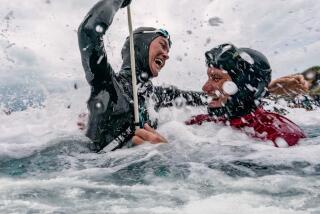Before you dive, be sure to certify
- Share via
FOR many travelers, a scuba vacation is either first on the list or an afterthought.
Diving is a safe and exhilarating way to explore the wonders of the deep, but it requires confidence and ability. Under the right supervision, though, virtually anyone can dive.
From choosing a certified dive operator to picking your destination, gathering as much information as possible is a good first step to shake pre-dive jitters. So jump in and get wet. There’s a whole other world out there ready to be discovered.
Before you book that flight to Cozumel, Mexico, or the Cayman Islands, take an introductory course at a local dive shop to see if scuba is right for you. To get new divers accustomed to the underwater experience, shops typically offer get-acquainted classes, where you’re taught the basics of breathing while safely submersed in a shallow pool.
If after 10 minutes underwater you still feel unsure, at least you can say you tried.
Perhaps the most important part of learning to dive is having a certified dive operator instructing you.
Before you dive, make sure your instructors are certified by the Professional Assn. of Diving Instructors, 30151 Tomas St., Rancho Santa Margarita, CA 92688; (800) 729-7234, www.padi.com, or the National Assn. of Underwater Instructors, P.O. Box 89789, Tampa, Fla. 33689; (800) 553-6284, www.naui.org.
Popular diving destinations often are flooded with inexperienced operators, so protect yourself and ask.
Also, check how long they’ve been in business and how many dives their instructors have logged -- the more the better.
Becoming a certified diver under a PADI or NAUI operator is performance-based, so the process can be as long or as short as you make it.
A PADI Open Water Diver course, for example, can be completed in six sessions in as few as three days or as long as six weeks.
Once you’ve demonstrated that you’ve mastered the required skills and knowledge, you’ll be awarded your certification and you’ll be ready for your first open-water dive.
Your tanks, breathing control, regulator and wet suit probably will be provided by your dive operator, but it’s a good idea to buy your own fins, snorkel and mask. This will ensure a good fit on all of your personal equipment. Have your dive operator point you toward well-made products in your price range, but generally speaking, a snorkel and mask shouldn’t cost more than $100.
Fins range widely in price, so it’s best to stick with the basics to start.
As for your mask, it’s important to buy one with the best fit, making sure it keeps a tight suction on your face. And the snorkel mouthpiece should fit comfortably.
The most exciting part of scuba diving is witnessing the array of marine life. From colorful tropical fish to the coral heads and walls, the plethora of life underwater can astound even the most experienced diver. Help it stay that way.
Do your part, and don’t touch what you see. The oils from your fingers are enough to kill coral that’s taken decades to grow a fraction of an inch.
After you become certified and you start logging dives, it’s hard to think of doing anything else. The good news is that there’s a lot of ocean out there and plenty of ways to see it.
And after you become an open-water diver, PADI and NAUI offer several specialty dive courses to keep things interesting when you’re down below.
Try diving to a 19th century shipwreck in the British Virgin Islands or getting certified in underwater photography. Or go on a night dive with nothing but floodlights, or a deep-sea dive at more than 100 feet. There are many things to see. You just need to take the first step.
More to Read
Sign up for The Wild
We’ll help you find the best places to hike, bike and run, as well as the perfect silent spots for meditation and yoga.
You may occasionally receive promotional content from the Los Angeles Times.




